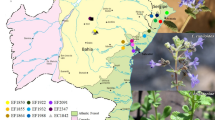Abstract
Salix L. (willow) is the largest genus of the family Salicaceae and plays an important role in riparian habitats, wetlands and in shrub tundra. Due to the different implications for the species belonging to this family, it is fundamental to identify molecular tools characterizing relevant clones. A set of six multilocus and multiallelic simple sequence repeat (SSRs) markers are presented, leading to 390 polymorphic fragments considered as single dominant markers and able to discriminate successfully 92 S. alba L. from 24 Salix spp. The polymorphic fragments have been used to perform genetic diversity studies, and to investigate population structures and cluster analysis in a germplasm collection. The results highlight the capability of the six SSRs to be powerful genetic resources in applied forestry research, both to distinguish S. alba clones from Salix spp. and to perform genetic population studies for breeding programs.



Similar content being viewed by others
References
Argus GW (1997) Infrageneric classification of New World Salix L. (Salicaceae). Syst Bot Monogr 52:1–121
Argus GW, Eckenwalder JE, Kiger RW (2010) Salicaceae. In: Kiger RW (ed) Flora of North America. Oxford University Press, Oxford
Barcaccia G, Meneghetti S, Albertini E, Triest L, Lucchin M (2003) Linkage mapping in tetraploid willows: segregation of molecular markers and estimation of linkage phases support an allotetraploid structure for Salix alba × Salix fragilis interspecific hybrids. Heredity 90:169–180
Barker JHA, Pahlich A, Trybush S, Edwards KJ, Karp A (2003) Microsatellite markers for diverse Salix species. Mol Ecol Notes 3(1):4–6
Botstein D, White RL, Skolnick M, Davis RW (1980) Construction of genetic linkage map in man using restriction fragment length polymorphisms. Am J Hum Genet 32:314–331
Bozzi JA, Liepelt S, Ohneiser S, Gallo LA, Marchelli P, Leyer I, Ziegenhagen B, Mengel C (2015) Characterization of 23 polymorphic SSR markers in Salix humboldtiana (Salicaceae) using next-generation sequencing and cross-amplification from related species. Appl Plant Sci 3:1400120
Earl DA, von Holdt BM (2012) STRUCTURE HARVESTER: a website and program for visualizing STRUCTURE output and implementing the Evanno method. Conserv Genet Resour 4(2):359–361
Evanno G, Regnaut S, Goudet J (2005) Detecting the number of clusters of individuals using the software STRUCTURE: a simulation study. Mol Ecol 14:2611–2620
Excoffier L, Lischer HE (2010) Arlequin suite ver 3.5: a new series of programs to perform population genetics analyses under Linux and Windows. Mol Ecol Resour 10:564–567
Falush D, Stephens M, Pritchard JK (2003) Inference of population structure using multilocus genotype data: linked loci and correlated allele frequencies. Genetics 164:1567–1587
Fang ZF, Zhao SD, Skvortsov AK (1999) Salicaceae. In: Wu Z, Raven PH (eds) Flora of China, vol 4. Missouri Botanical Garden Press, St. Louis, pp 139–274
Gupta A, Singh NB, Ginwal HS (2009) Molecular characterization and assessment of intraspecific relationship among Salix alba clones using RAPD markers. Ind J Biotech (Communicated)
Hamrick J, Godt M (1996) Effects of life history traits on genetic diversity in plant species. Philos Trans R Soc Lond B Biol Sci 351:1291–1298
Jakobsson M, Rosenberg NA (2007) CLUMPP: a cluster matching and permutation program for dealing with label switching and multimodality in analysis of population structure. Bioinformatics 23:1801–1806
Karp A, Hanley SJ, Trybush SO, Macalpine W, Pei M, Shield I (2011) Genetic improvement of willow for bioenergy and biofuels. J Integr Plant Biol 53:151–165
Lauron-Moreau A, Pitre FE, Brouillet L, Labrecque M (2013) Markers of willow species and characterization of 11 polymorphic microsatellites for Salix eriocephala (Salicaceae), a potential native species for biomass production in Canada. Plants 2(2):203–210
Perdereau AC, Kelleher CT, Douglas GC, Hodkinson TR (2014) High levels of gene flow and genetic diversity in Irish populations of Salix caprea L. inferred from chloroplast and nuclear SSR markers. BMC Plant Biol 14(1):202
Pritchard JK, Stevens M, Donnelly P (2000) Inference of population structure using multilocus genotype data. Genetics 155:945–959
Rousset F (1997) Genetic differentiation and estimation of geneflow from F-statistics under isolation by distance. Genetics 145:1219–1228
Singh NB, Joshi S, Choudhary P, Sharme JP (2013) SSR DNA marker aided genetic diversity assessment of selected willow clones. Genetika 45(2):527–536
Smulders MJM, van der Schoot J, Arens P, Vosman B (2001) Trinucleotide repeat microsatellite markers for black poplar (Populus nigra L.). Mol Ecol Notes 1:188–190
Trybush S, Jahodova S, Macalpine W, Karp A (2008) A genetic study of a Salix germplasm resource reveals new insights into relationships among subgenera, sections and species. Bioenergy Res. 1:67–79
Wang Z, Kang M, Liu H, Gao J, Zhang Z, Li Y, Wu R, Pang X (2014) High-level genetic diversity and complex population structure of Siberian apricot (Prunus sibirica L.) in China as revealed by nuclear SSR markers. PLoS ONE 9(2):e87381
Author information
Authors and Affiliations
Corresponding author
Additional information
Publisher's Note
Springer Nature remains neutral with regard to jurisdictional claims in published maps and institutional affiliations.
Project funding: This research was supported by the Project “RGV-FAO” (The Italian Ministry of Agricultural, Food and Forestry Policies-MiPAAF D.M. 18862/06).
The online version is available at http://www.springerlink.com
Corresponding editor: Yu Lei.
Rights and permissions
About this article
Cite this article
Carletti, G., Cattivelli, L., Vietto, L. et al. Multiallelic and multilocus simple sequence repeats (SSRs) to assess the genetic diversity of a Salix spp. germplasm collection. J. For. Res. 32, 263–271 (2021). https://doi.org/10.1007/s11676-019-00913-0
Received:
Accepted:
Published:
Issue Date:
DOI: https://doi.org/10.1007/s11676-019-00913-0




